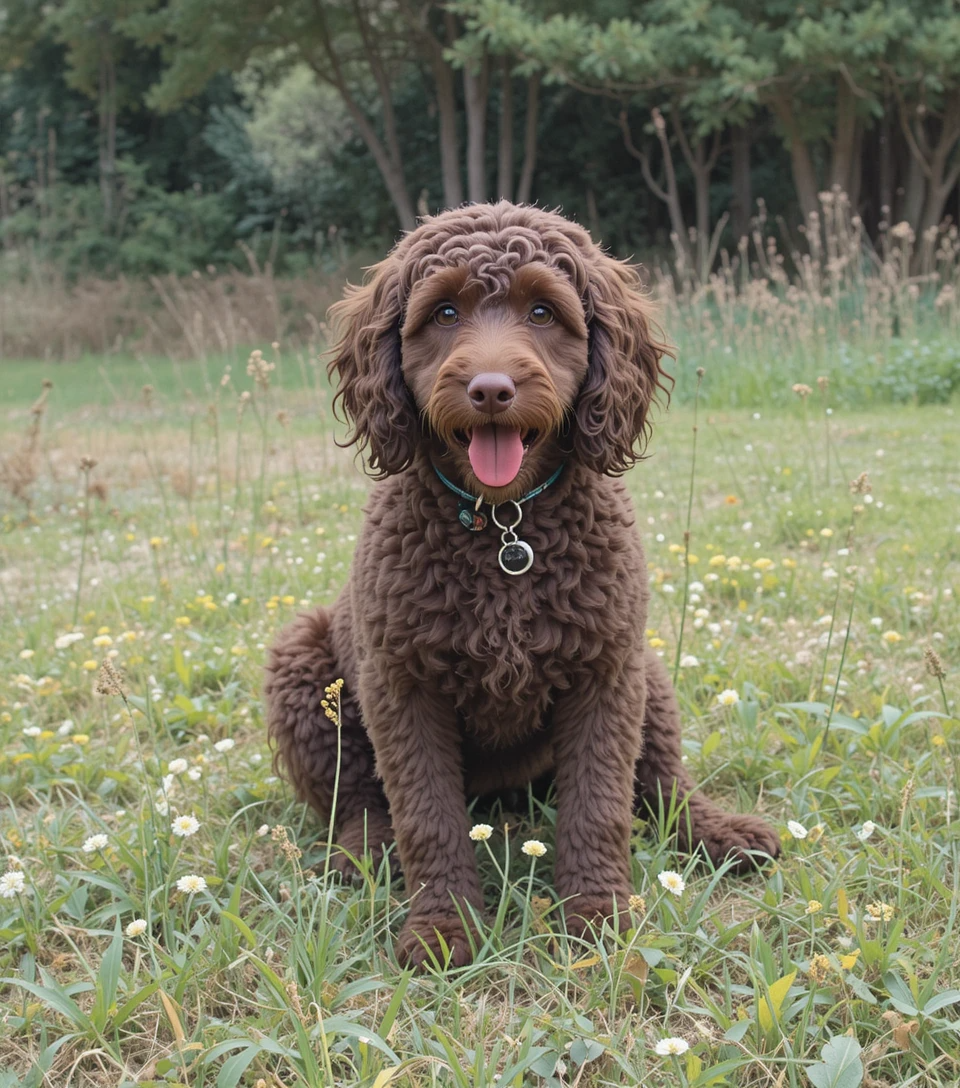Bringing a chocolate Labradoodle into your home is such an exciting adventure! These friendly, intelligent dogs are not only adorable but also make wonderful companions. I remember when I first brought mine home, I was instantly drawn to their affectionate nature and how quickly they bonded with the family. Their hypoallergenic coats are another great perk, especially for families with allergies. As you get started on raising your Labradoodle, you’ll learn that it’s a journey filled with lots of love and a few challenges along the way.
Raising a happy, healthy chocolate Labradoodle takes some work, but it’s incredibly rewarding. From training tips to grooming advice, you’ll want to ensure they’re getting the care they need. Regular grooming, socialization, and mental stimulation are key to helping your dog grow into a well-behaved, balanced adult.
Table of Contents
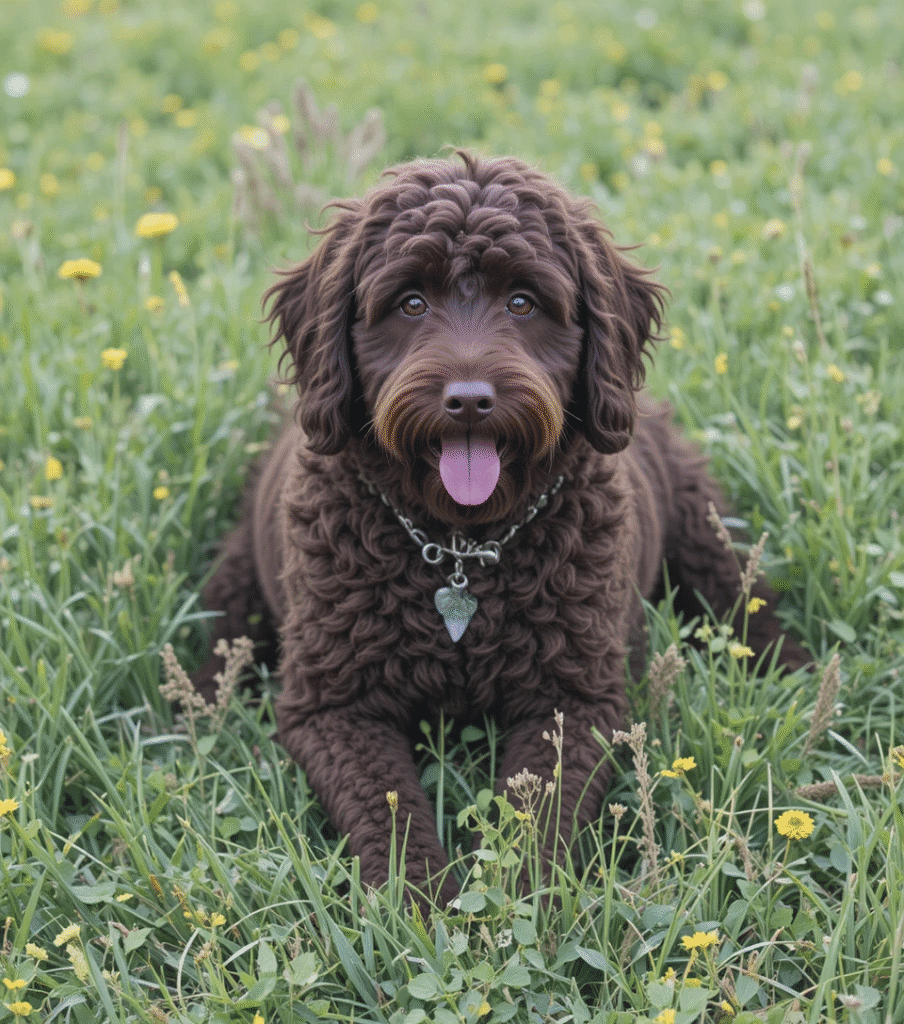
The Journey of Raising a Chocolate Labradoodle
Getting to Know Your Chocolate Labradoodle
Chocolate Labradoodles are a wonderful mix of the Labrador Retriever and the Poodle, known for their curly coats and beautiful warm brown color. These dogs inherit the best qualities from both parent breeds, including their intelligence, friendliness, and playful demeanor. I remember when I first saw a chocolate Labradoodle, I was immediately struck by how they combined the energy and playfulness of a Labrador with the elegance and cleverness of a Poodle.
These Labradoodles come in a variety of sizes, depending on the size of the Poodle parent used in breeding. They can be standard, medium, or miniature, which makes it easier to find the right fit for your home and lifestyle. Whether you’re looking for a larger companion or a more compact pup, the chocolate Labradoodle is a perfect match for families due to their loving nature and the great traits they inherit from both the Labrador and the Poodle.
History and Origins
The Chocolate Labradoodle was first bred in Australia in the 1980s with the goal of creating a guide dog that was also suitable for people with allergies. This breed quickly gained popularity thanks to its friendly nature and low-shedding coat, which made it an ideal companion for families, especially those with allergy concerns. I remember learning about how the Labradoodle was designed to be both a loving companion and a functional service dog, which made them so special.
Chocolate Labradoodles are particularly valued for their rich, appealing coat color, which can range from deep dark chocolate to a lighter mocha shade. This color variety, combined with their hypoallergenic nature, has made them even more sought after. The history behind this breed adds to its charm, as it was carefully crafted to serve a purpose while also becoming a beloved family pet.
Temperament and Personality
Chocolate Labradoodles are truly known for their affectionate and social nature. From the moment I brought mine home, I could see how much they thrive on human interaction. These dogs are wonderful with children and other pets, making them an excellent choice for families. Their intelligence is remarkable, making them very easy to train, though they can also get a bit mischievous if they’re not properly engaged.
Keeping your Labradoodle happy means providing both mental and physical stimulation regularly. I’ve learned that without enough engagement, they can get bored and show some mischievous behaviors. But when they’re given the right amount of attention, they’re incredibly loving, well-behaved, and a joy to be around. Regular stimulation is key to maintaining a happy and balanced Labradoodle
Preparing Your Home for a Chocolate Labradoodle
Before bringing your Labradoodle puppy home, it’s important to prepare your living space. A safe, welcoming environment will help your puppy adjust smoothly to their new surroundings. I remember when I first brought my chocolate Labradoodle home, I made sure to puppy-proof the house by removing any hazards and creating a cozy, designated area for them. It’s also essential to set up a comfortable space where they can sleep and feel secure.
Taking these steps in advance will make the transition for your new puppy much easier. A well-prepared home helps them adjust quickly and reduces stress. Ensuring that your space is both safe and welcoming will create a smooth start for both you and your new Labradoodle companion.
Puppy-Proofing Your Home
When you bring a Labradoodle puppy into your home, it’s important to puppy-proof your space to keep your curious and energetic pup safe. I remember the first time I brought my chocolate Labradoodle home, and I quickly realized that securing things like electrical cords and keeping small objects off the floor made a huge difference. Puppies love to explore, and removing any hazards from their reach is crucial to prevent accidents.
Setting up a designated area for your puppy with a comfortable bed, some toys, and plenty of water will give them a sense of security in their new environment. Making sure any toxic plants or substances are out of reach is another important step. These simple steps will help your puppy feel more at ease and allow them to explore their new home safely.

Essential Supplies
When preparing for your chocolate Labradoodle, having the right supplies will make the transition smoother for both you and your puppy. A crate is a must-have to provide a safe space and help with house training. I remember using a crate for my Labradoodle, and it really helped him feel secure while he adjusted to his new home. You’ll also need soft, washable bedding to keep your puppy comfortable and clean, as well as food and water bowls. Stainless steel bowls are durable, easy to clean, and perfect for daily use.
In addition, don’t forget about toys. I found that having a mix of chew toys, interactive toys, and comfort toys was essential for mental and physical stimulation. Lastly, a sturdy leash and adjustable collar are crucial for walks and training. These supplies will ensure your puppy has everything they need to settle in and thrive in their new home.
Training Your Chocolate Labradoodle
Training is a very crucial part of raising a well-behaved chocolate Labradoodle. These dogs are naturally intelligent and have a strong eagerness to please, which makes them quick learners. When I started training my Labradoodle, I noticed that he picked up commands fast, but it was important to be consistent with the training. Setting a routine and sticking to it helps a lot, especially with a dog that loves to learn.
To make the training process even more effective, positive reinforcement is key. Rewarding your puppy with treats and praise when they get something right encourages them to keep learning. I’ve found that being patient and using rewards makes training much more enjoyable for both me and my dog. With the right approach, your Labradoodle will quickly become the well-mannered companion you’ve always wanted.
House Training
House training your Labradoodle requires a good deal of patience and a consistent routine. I found that taking my puppy outside frequently, especially after meals, naps, and playtime, made a huge difference in how quickly she learned where to go. Puppies love routine, so sticking to a regular schedule is key for success. The more you take them out, the faster they will catch on.
Whenever my Labradoodle would eliminate outside, I would praise and reward her to reinforce good behavior. It’s important to avoid punishment, as it can create unnecessary fear and confusion for your puppy. By offering lots of positive reinforcement and being patient, house training can be a smooth process.
Teaching Basic Commands
When raising a chocolate Labradoodle, teaching basic commands like “sit,” “stay,” “come,” and “leave it” is essential for both safety and good behavior. I’ve found that using positive reinforcement such as treats and praise encourages my puppy to learn faster and enjoy the process. It’s important to keep training sessions short and frequent, as they are more effective than longer, infrequent ones. These small, consistent sessions will help your puppy understand what’s expected of them without getting bored.
Training is a bonding experience, and it’s rewarding to see your Labradoodle respond to commands. As you continue to reinforce the commands with rewards, your puppy will become more obedient and well-behaved. It’s the little steps like these that help shape a happy, well-trained dog.
Positive Reinforcement in Training
Using positive reinforcement is a key part of raising a well-behaved chocolate Labradoodle. When you reward your dog for good behavior, whether it’s with treats, praise, or affection, it helps build trust and strengthens your bond with them. This approach encourages your dog to repeat the desirable actions, creating a positive learning environment. It’s essential to stay consistent with your rewards so your Labradoodle understands what behaviors are expected and appreciated.
In my experience, positive reinforcement not only improves training but also deepens the connection between you and your dog. By rewarding the right behaviors, you show your dog that they can trust you, and this trust makes your relationship stronger. Over time, your Labradoodle will eagerly engage in daily interactions, knowing that good behavior leads to positive outcomes like treats and extra affection.
Socialization
Socializing your Labradoodle puppy is a key step in raising a well-rounded, confident dog. From the moment I brought my puppy home, I made sure to expose him to different people, various environments, and even other animals. Early exposure helps them adapt to new experiences, making them more comfortable and less fearful as they grow. Socialization is essential to help your puppy develop the right social skills, and it’s a crucial part of their development.
One great way to ensure your puppy gets the right exposure is by enrolling them in a puppy socialization class. These classes provide controlled, positive experiences that help build your puppy’s confidence. I found these classes very helpful in teaching my puppy how to interact with others in a safe, structured way. Socializing early on can set them up for a happy, balanced life as they grow.
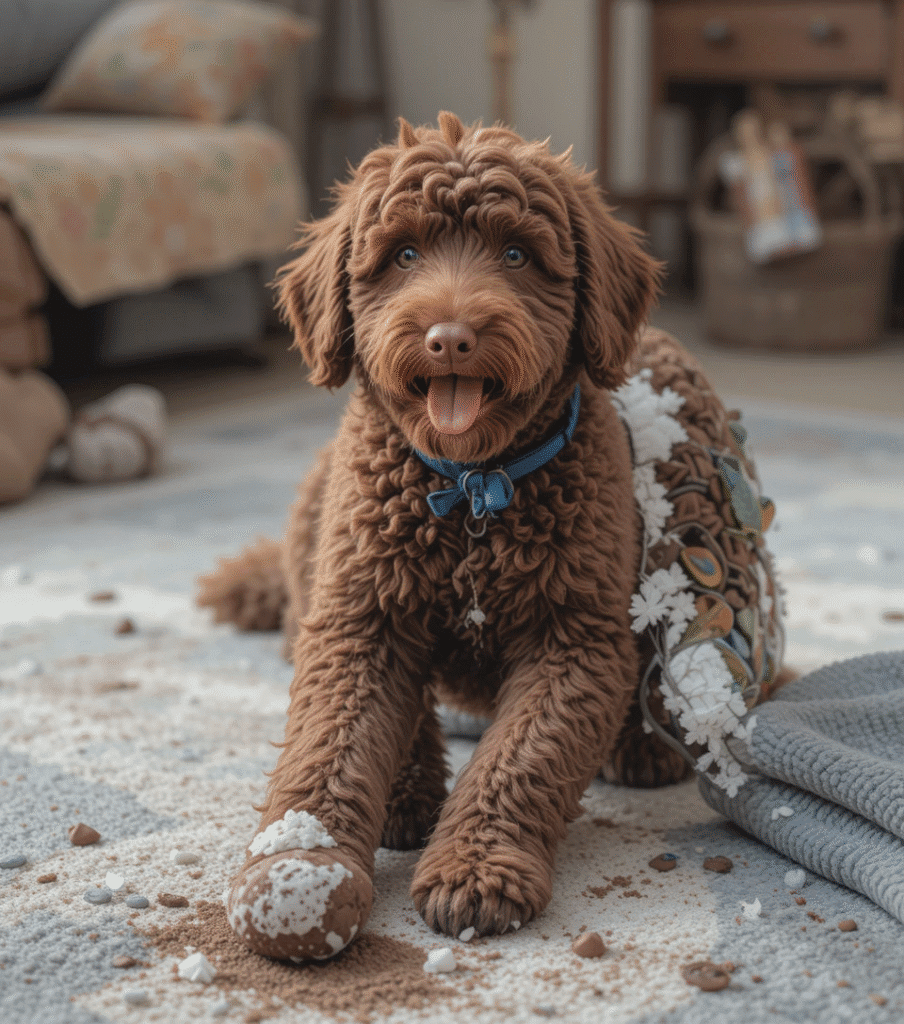
Care For Chocolate Labradoodle
Grooming Your Chocolate Labradoodle
Chocolate Labradoodles require regular grooming to keep their coat healthy and tangle-free. I’ve noticed that the curly, hypoallergenic coat can be a bit high-maintenance, but with the right tools and techniques, grooming can turn into an enjoyable bonding experience. I remember when I first started grooming my puppy, it was a learning process for both of us. However, once I had the right grooming tools, it became a relaxing routine.
It’s essential to stay consistent with brushing and trimming to prevent mats and tangles. Grooming time is a great opportunity to bond with your Labradoodle, and as they get used to the process, it becomes a fun activity. With the right approach, grooming can be something both you and your puppy look forward to, helping to maintain a shiny and healthy coat.
Brushing and Bathing Your Labradoodle
Regular brushing is essential to keep your Labradoodle’s coat healthy and prevent matting or tangles. I found that brushing at least three times a week with a slicker brush or a comb designed for curly coats works wonders. It not only keeps their fur neat but also helps reduce shedding. When I started brushing my chocolate Labradoodle, it became a relaxing bonding moment for both of us, and it made a noticeable difference in her coat’s health.
Bathing should be done every 4-6 weeks or when necessary. Use a gentle dog shampoo to keep your puppy’s skin and coat in top condition. I’ve noticed that bathing regularly helps maintain their hypoallergenic coat and ensures they stay fresh. Just remember, consistency with brushing and bathing will keep your Labradoodle looking and feeling great.
Dental Care for Your Labradoodle
Taking care of your Labradoodle’s dental health is often overlooked but is an essential part of grooming. Regular brushing with dog-safe toothpaste and offering dental chews can help prevent many dental issues. I make it a point to brush my chocolate Labradoodle’s teeth several times a week, which keeps her teeth clean and her gums healthy. I also schedule professional cleanings when needed to ensure her teeth are in top condition.
Not only does maintaining dental hygiene help prevent bad breath, but it also promotes overall health for your puppy. Regular brushing helps avoid the build-up of plaque and tartar, keeping her teeth strong and healthy. Taking care of your Labradoodle’s teeth is just another way to show love and ensure a long, happy life together.
Health and Nutrition for Your Chocolate Labradoodle
Taking care of your chocolate Labradoodle’s health requires attention to nutrition, regular vet visits, and an active lifestyle. I’ve learned that providing a balanced diet is key to ensuring my puppy stays healthy and full of energy. Regular vet checkups also help monitor their well-being, ensuring there are no underlying health issues. It’s important to keep up with preventive care to catch any potential problems early, which will lead to a longer, healthier life for your pup.
In my experience, making sure that my Labradoodle gets the right nutrition and stays active is essential for their overall happiness. They thrive when they have the right mix of nutrition, care, and exercise. Whether it’s through regular walks or playtime, an active lifestyle ensures that your Labradoodle stays fit, happy, and healthy.
Feeding Your Labradoodle
Feeding your chocolate Labradoodle the right food is crucial to keeping them healthy and happy. High-quality dog food that meets their nutritional needs is essential. Look for food that lists real meat as the first ingredient and avoid fillers like corn and soy. These ingredients may not provide the best nutrition for your dog. The amount of food you give your Labradoodle will depend on their age, size, and activity level, so be sure to adjust their portions accordingly.
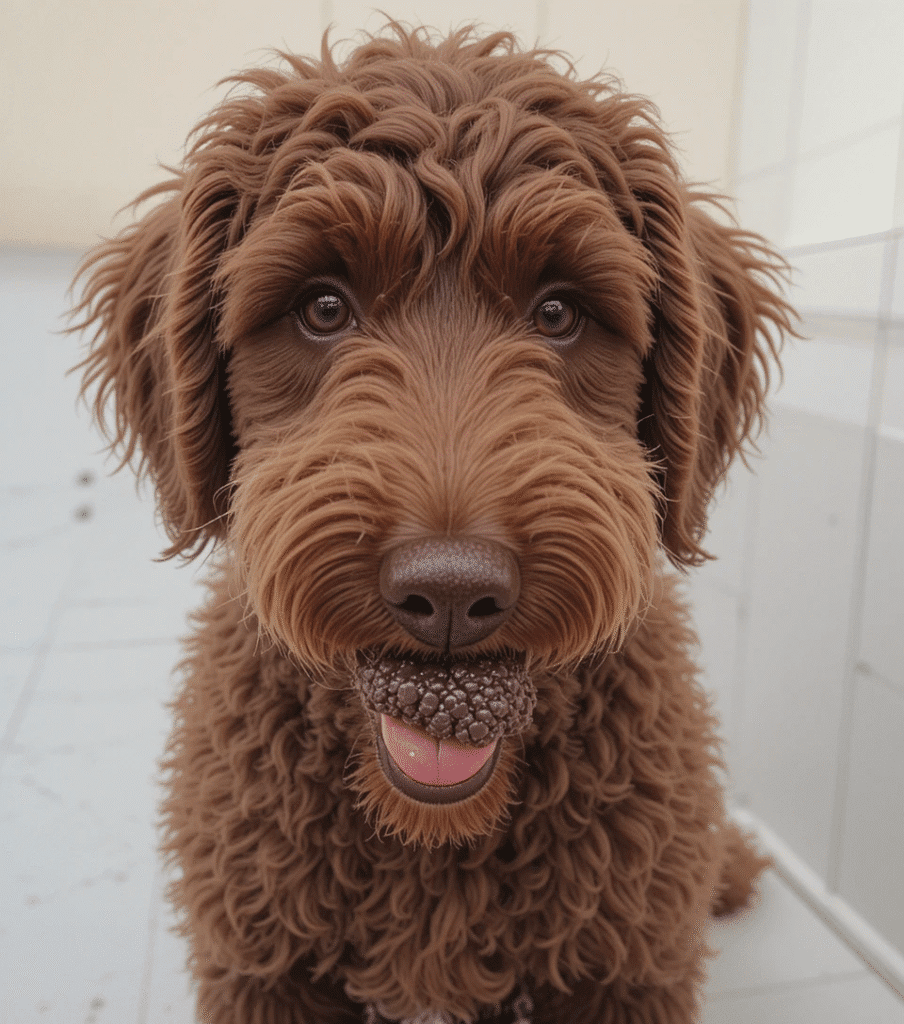
In my experience, consulting a veterinarian for specific dietary recommendations can really help ensure you’re giving your dog the best possible nutrition. I always make sure to check with my vet to keep my Labradoodle on a balanced diet, which helps them maintain a healthy weight and energy levels. Whether it’s choosing the right food or adjusting the portions, proper feeding is key to raising a happy, healthy Labradoodle.
Regular Veterinary Care
Keeping your chocolate Labradoodle healthy requires more than just daily care. Regular vet visits are essential for preventive care and to catch any potential health issues early on. Make sure to stay on top of important things like vaccinations, flea and tick prevention, and heartworm prevention to keep your Labradoodle protected. Annual check-ups are a great way to monitor your dog’s overall health and address any concerns you might have.
In my experience, visiting the vet regularly ensures that my Labradoodle stays healthy and happy. I always make sure to keep their vaccinations up to date and regularly check for any potential health problems, as it can prevent serious issues in the long run. With these precautions, you can help your Labradoodle live a long and healthy life.
Exercise and Mental Stimulation
To keep your Chocolate Labradoodle happy and healthy, it’s important to provide plenty of physical exercise and mental stimulation. These active dogs need daily walks, time for playtime, and activities like puzzle toys or agility training to stay sharp and fit. Incorporating a variety of activities into their routine helps prevent boredom, which can lead to destructive behavior. Engaging your Labradoodle in mental stimulation keeps their mind sharp, and providing physical activities helps maintain their health and happiness. By ensuring they have both, you’re setting your dog up for a fulfilling, well-rounded life.
Building a Strong Bond with Your Chocolate Labradoodle
When raising a chocolate Labradoodle, building a strong bond is crucial for fostering a healthy and harmonious relationship. The trust you establish with your dog plays a vital role in this process. Consistency in your actions and positive interactions are essential components that help you form a lasting connection. The more you practice patience and understanding, the stronger the relationship will become. Through consistent routines and lots of love, you’ll notice how the bond strengthens over time.
Creating a lasting relationship with your chocolate Labradoodle is about more than just daily walks or feeding. It’s about establishing trust through positive reinforcement and ensuring that your interactions are consistent. This forms the foundation of a deep connection with your dog, where both of you feel secure and cared for. As you continue to spend time together, whether it’s through play or simple moments of affection, your trust will grow, and so will the bond that defines your relationship with your furry friend.
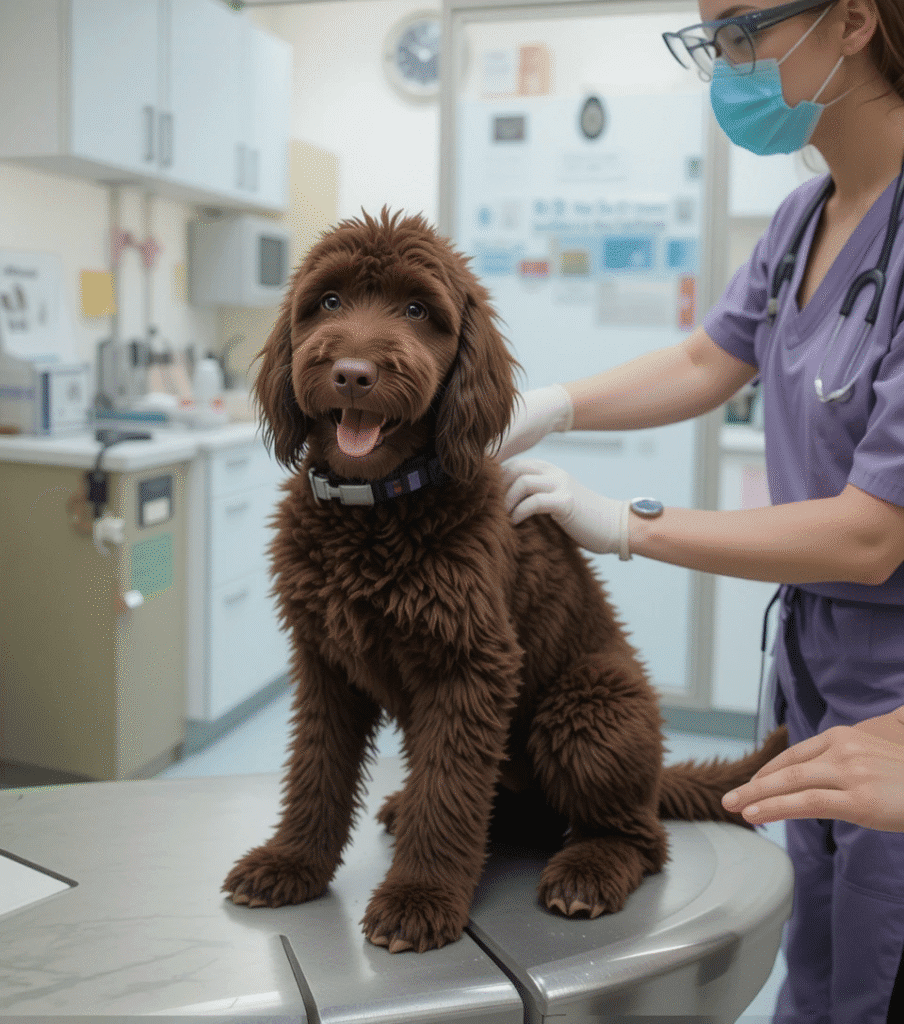
Quality Time with Your Chocolate Labradoodle
Spending quality time with your Labradoodle is key to their emotional well-being. It’s important to engage in activities your dog enjoys, whether it’s playing fetch, going for hikes, or simply cuddling on the couch. These moments not only strengthen your bond but also provide mental stimulation and physical stimulation. I’ve found that even just a few minutes of shared fun can go a long way in helping your dog feel happy and secure.
Every moment you spend together reinforces the connection between you and your Labradoodle. Whether it’s an active play session or a calm time resting together, these activities contribute to your dog’s overall happiness and health. Quality time ensures that your dog feels loved and mentally fulfilled, making it a cornerstone of your relationship.
Understanding Your Chocolate Labradoodle’s Needs
To raise a happy and healthy Labradoodle, it’s important to pay attention to their body language and behavior. By doing so, you can better understand their needs and preferences. For example, if you notice signs of stress, anxiety, or discomfort, it’s crucial to address these issues promptly. This not only ensures your dog’s well-being but also strengthens the bond you share.
From personal experience, observing your dog’s cues can help you provide the right care and create a more comfortable environment for them. Understanding your Labradoodle‘s signals allows you to maintain a happy, healthy dog, and can even prevent future problems by catching issues early.
Final Thought
Raising a chocolate Labradoodle is a truly rewarding experience. They bring so much love and joy into your life, though it comes with its own set of challenges. To ensure your dog grows up to be a happy, well-adjusted adult, it’s important to focus on understanding their unique needs. Consistent training, proper grooming, and balanced nutrition are key elements in raising a healthy and happy dog. And, of course, plenty of love is essential.
In my experience, taking the time to meet your Labradoodle‘s needs through these areas makes all the difference. Whether you’re welcoming a puppy into your family or working with an adult dog, these efforts ensure your pet is set up for a long, happy life.
Bernedoodle vs Labradoodle 7Facts&Info Exposed
Black Labradoodle Breed Info, Pictures, Origin 2025

